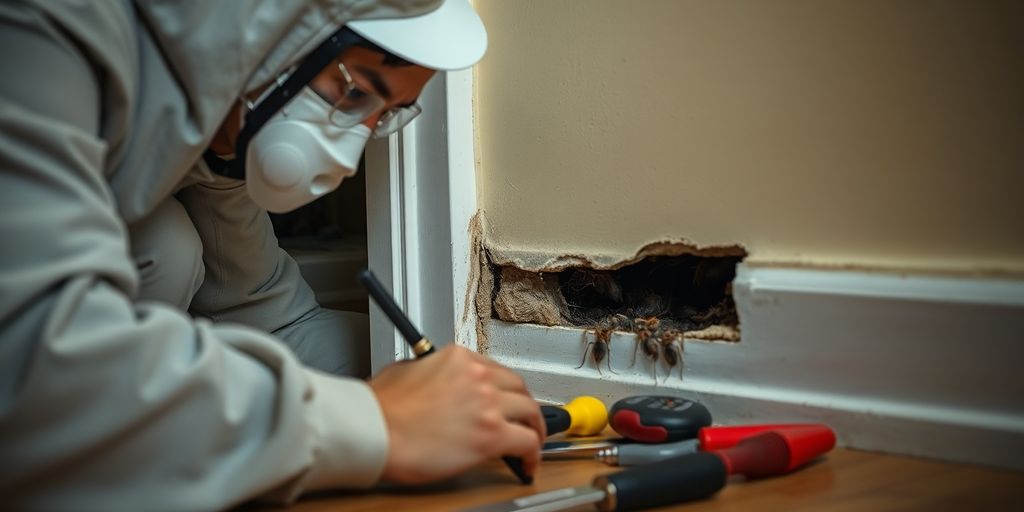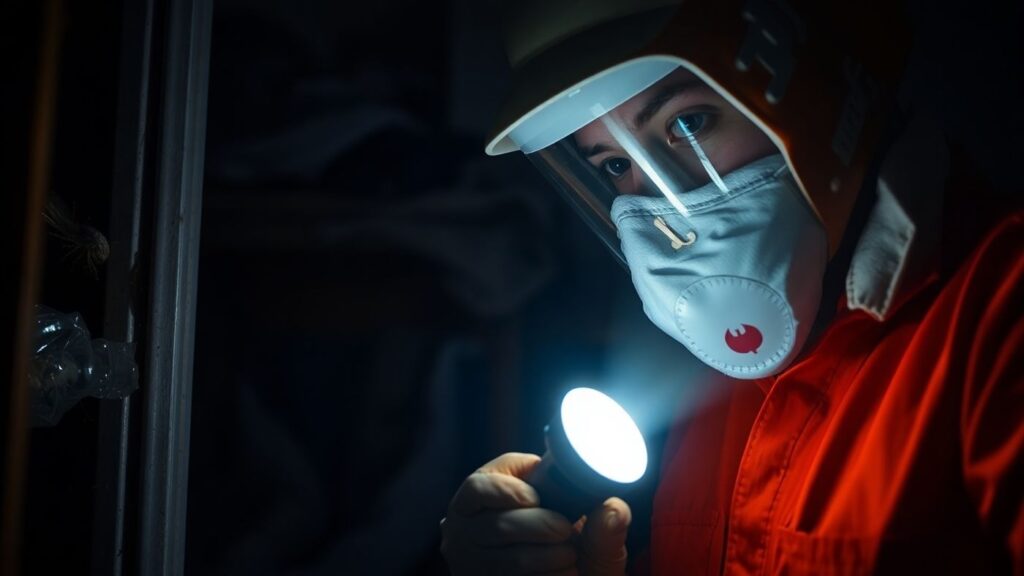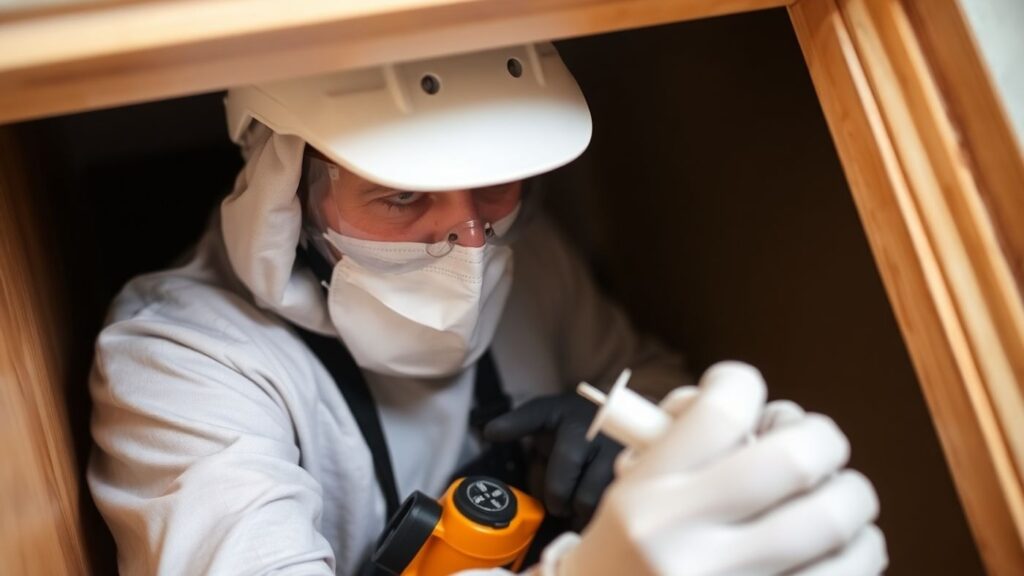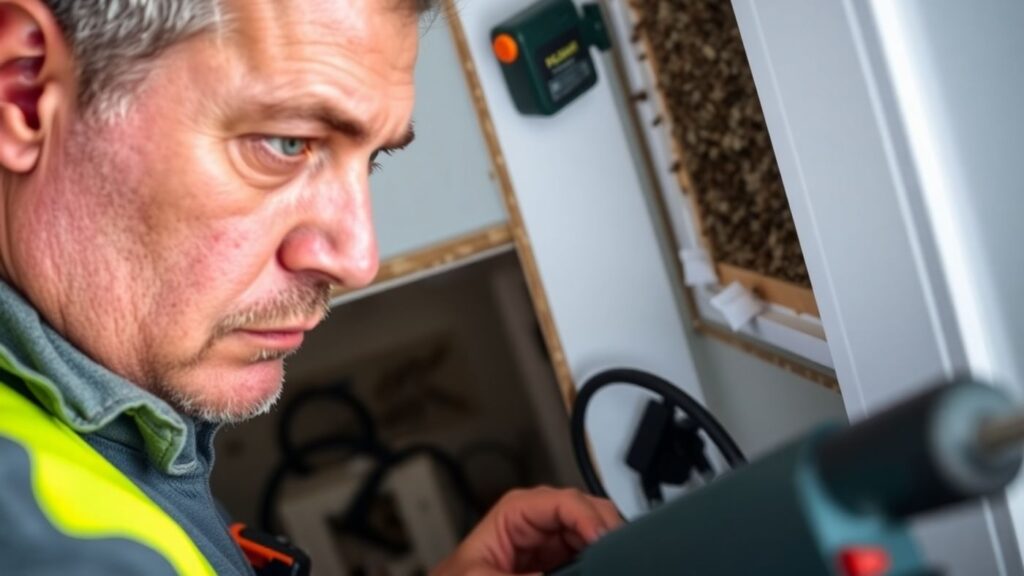
Ever wondered what lurks behind those walls or under the floorboards? Exterminators in the area have seen it all. From bizarre pest hideouts to unexpected infestations, these professionals are the unsung heroes keeping our homes safe and sound. Their stories are not just about eliminating pests but also about discovering the unexpected in places you’d least expect.
Key Takeaways
- Exterminators often find pests in the most unexpected places, like inside electronics or behind wallpaper.
- Professional exterminators have the tools and knowledge to handle infestations that DIY methods can’t tackle.
- Regular pest inspections by professionals can prevent costly damage to homes.
- The presence of pests doesn’t always mean a home is dirty; even clean homes can have infestations.
- Exterminators play a crucial role in maintaining public health by preventing the spread of diseases carried by pests.
Uncovering the Unexpected: What Exterminators in the Area Discovered

Hidden Infestations Revealed
You might think pests are easy to spot, but that’s not always the case. Exterminators often find infestations in the most unexpected places. For instance, ants can set up colonies inside walls or even in a box of old envelopes. Roaches might hide in safes, and rodents can make a home in your car’s dashboard. The ability of pests to adapt and thrive in unusual environments is truly astonishing. It’s not just about finding a hiding spot; it’s about finding a place that meets their needs, like food and moisture.
Surprising Pest Habitats
In their line of work, exterminators encounter all sorts of bizarre pest habitats. Bugs and rodents don’t need much to settle in and can live almost anywhere. From the tiny crevices in your walls to the forgotten corners of your garage, pests can turn any space into a comfortable home. They’ve been found in places you’d never expect, such as behind baseboards or in the seams of mattresses. Recognizing these strange odors, like musky smells from rodent infestations, can be a clue to their presence.
The Role of Professional Exterminators
Professional exterminators play a crucial role in uncovering these hidden pests. With their expertise and tools, they can identify and eliminate infestations that homeowners might miss. They know where to look and what signs to watch for, ensuring that even the sneakiest pests are found and dealt with. Their work not only helps maintain a pest-free environment but also prevents potential health risks and property damage caused by these unwelcome guests.
Exterminators are like detectives, piecing together clues to find the hidden culprits in our homes. Their work goes beyond just eliminating pests; it’s about understanding their behavior and finding long-term solutions to keep them at bay.
The Most Unusual Finds by Exterminators in the Area
Bizarre Pest Locations
Exterminators never know what they might stumble upon in their line of work. Pests have a knack for setting up camp in the most unexpected places. Imagine opening a safe, expecting valuables, only to find a thriving roach community. Or discovering an entire ant colony making a home out of a box of envelopes. Mice have been known to cozy up inside car dashboards, adding an unexpected twist to vehicle maintenance.
Unexpected Pest Behavior
Pests can be surprisingly adaptable, often displaying behavior that defies expectations. For instance, fire ants, not typically indoor nesters, have been found in garages and walls, exploiting tiny crevices to establish their colonies. Another curious behavior is how American roaches manage to survive in dry places like libraries by seeking out moisture from unlikely sources such as window sills.
Lessons Learned from the Field
The field of pest control teaches exterminators to anticipate the unexpected and think creatively. Understanding pest preferences is crucial, but even the most seasoned professionals can be caught off guard by a pest’s choice of habitat. The key lesson? Always be prepared for surprises, as pests are masters of adaptation and can thrive in the most improbable environments.
How Exterminators in the Area Handle Uncommon Pest Problems
Specialized Techniques for Unique Challenges
When dealing with unusual pest problems, exterminators often need to think outside the box. Every pest issue is unique, and sometimes the usual methods just won’t cut it. For example, when pests invade unusual places like electrical outlets or inside walls, standard sprays might not reach them. Here, exterminators might use techniques like baiting systems or targeted dust applications that can penetrate these hard-to-reach areas. Sometimes, they even use heat treatments to eliminate pests without chemicals.
Tools of the Trade
Exterminators come equipped with a variety of tools to tackle these challenges. Some of the key tools include:
- Infrared Cameras: To detect pests in hidden areas without tearing down walls.
- Bait Guns: For precise application of baits in small or hard-to-reach places.
- Microscopic Scopes: To identify tiny pests and their eggs, ensuring nothing is missed.
These tools allow exterminators to address the problem effectively, minimizing damage to the property.
Case Studies of Success
Exterminators have faced some pretty odd situations. Take, for instance, the case where a family kept hearing noises in their attic. It turned out to be a colony of bats. The exterminators used a combination of netting and one-way doors to let the bats leave but not return. In another case, a house had a mysterious foul odor, which was traced back to a hidden termite infestation. The exterminators used a special detection system to find and treat the termites without having to rip up the floors.
Uncommon pest problems require a blend of creativity, patience, and the right tools. Exterminators are like detectives, piecing together clues to find the best solution. It’s not just about killing bugs; it’s about understanding them and outsmarting them.
The Importance of Professional Exterminators in the Area

Why DIY Methods Often Fail
Trying to handle pest problems on your own can be like trying to fix a leaky pipe with duct tape. Sure, it might work for a little while, but pests are sneaky and persistent. They hide in places you’d never think to look and come back just when you think you’ve got them beat. DIY methods often lack the precision and thoroughness needed to eliminate pests for good. Without the right tools and knowledge, you might just be putting a temporary bandage on the problem.
The Expertise of Trained Professionals
Professional exterminators are like detectives. They know how to find the signs of pests that most people would miss. From identifying droppings to spotting entry points, their trained eyes can catch what you can’t. Exterminators have access to specialized equipment and treatments that aren’t available to the general public. This means they can tackle infestations more effectively and safely.
Ensuring Long-Term Pest Control
It’s not just about getting rid of pests today; it’s about keeping them away tomorrow. Exterminators provide ongoing maintenance and advice to prevent future infestations. They create a tailored plan that considers your home’s unique needs and vulnerabilities. This proactive approach helps ensure that pests don’t make a comeback, saving you time and money in the long run.
Professional exterminators offer peace of mind, knowing that your home is protected by experts who understand the ins and outs of pest control. They don’t just treat the problem; they help prevent it from happening again.
Common Myths About Pest Control Debunked by Exterminators in the Area

Myth: Clean Homes Are Pest-Free
It’s a popular belief that maintaining a spotless home ensures it remains pest-free. Unfortunately, this is not entirely true. Pests like cockroaches, ants, and rodents are primarily drawn to food sources and shelter, not dirt. Even the most pristine homes can provide these essentials. Clutter gives pests hiding spots, while food crumbs or unsealed pantry items can attract them. Regular cleaning helps, but it doesn’t guarantee a pest-free environment.
Myth: DIY Solutions Are Sufficient
Many homeowners believe they can handle pest problems with DIY solutions. While some minor issues might be manageable, most pest infestations require professional intervention. Exterminators have access to specialized tools and treatments that aren’t available to the general public. They also understand pest behavior, which is crucial for effective eradication. Relying solely on DIY methods can lead to recurring infestations and increased damage over time.
Myth: Pests Are Easy to Spot
The assumption that pests are easy to detect is misleading. Most pests are experts at hiding. For instance, bed bugs can nest in mattress seams, and termites can chew through wood undetected. Often, by the time you see signs of pests, they have already established a significant presence. Professional exterminators are trained to identify these hidden threats before they become severe, ensuring your home remains safe and pest-free.
The Hidden Dangers Lurking in Homes: Insights from Exterminators in the Area
Health Risks of Pest Infestations
Pests aren’t just creepy; they can pose serious health risks. From allergens to diseases, these unwelcome guests can make you sick. Cockroaches, for instance, can trigger asthma attacks and allergies, especially in children. Rodents, on the other hand, can spread diseases like hantavirus and salmonella through their droppings and urine. Bed bugs, while not known to spread disease, can cause itchy welts and allergic reactions. It’s crucial to address these infestations promptly to protect your health.
Structural Damage Caused by Pests
Termites are the silent destroyers of the pest world. They chew through wood, flooring, and even wallpaper, often going unnoticed until the damage is severe. Carpenter ants, though less destructive, also cause significant harm by burrowing into wood to build their nests. Meanwhile, rodents can gnaw through electrical wires, posing a fire hazard. The structural integrity of your home is at risk if these pests are left unchecked.
Preventative Measures to Take
Preventing pest infestations is all about being proactive. Here are some steps you can take:
- Seal cracks and openings around your home to block entry points.
- Keep your home clean and free of clutter, which can serve as hiding spots for pests.
- Store food in airtight containers to prevent attracting pests.
- Regularly inspect your home for signs of pests, such as droppings or chewed materials.
Even if you can’t see them, pests might still be lurking. Regular inspections by a professional can catch infestations early, saving you from costly repairs and health issues.
These preventative measures, along with professional help, can keep your home safe from the hidden dangers pests bring. Remember, a clean home doesn’t always mean a pest-free home. Stay vigilant and informed.
The Evolution of Pest Control: Insights from Exterminators in the Area
Advancements in Pest Control Technology
Pest control has come a long way, thanks to technology. Modern exterminators now use advanced tools like thermal imaging and electronic monitoring to detect pests early. These gadgets help identify infestations hidden in walls or under floors. Gone are the days when pest control was just about spraying chemicals. Now, eco-friendly solutions are becoming more popular, reducing harm to the environment while still being effective.
Eco-Friendly Pest Control Solutions
In recent years, there’s been a significant shift towards eco-friendly pest control methods. Exterminators are now using natural predators and organic compounds to manage pest populations. This not only protects the environment but also ensures the safety of pets and children in the home. Homeowners are increasingly opting for these green solutions, understanding the long-term benefits of a healthier living space.
The Future of Pest Management
Looking ahead, the future of pest control is promising. We can expect more integration of smart technology, like automated traps and drones, to manage pests efficiently. These innovations will allow for real-time monitoring and quicker response times, making pest control more proactive than ever. As technology continues to evolve, so will the strategies used by exterminators to keep homes and businesses pest-free.
The journey of pest control is a testament to how technology and environmental awareness can transform industries. As we embrace these changes, the role of exterminators becomes even more crucial in maintaining a balance between human habitation and the natural world.
The Role of Exterminators in the Area in Maintaining Public Health
Preventing Disease Spread
Exterminators play a crucial role in stopping diseases from spreading. Pests like rodents and insects can carry harmful pathogens that lead to diseases such as salmonella, Lyme disease, and hantavirus. Professional exterminators know how to identify and eliminate these pests, reducing the risk of disease transmission. By controlling the pest population, they help maintain a safer environment for everyone.
Protecting Food Supplies
Pests are notorious for contaminating food supplies. Insects like cockroaches and rodents can spread bacteria and viruses, making food unsafe. Exterminators work to protect food supplies by implementing strategies to prevent pest infestations in food storage and preparation areas. This not only safeguards public health but also supports the local economy by ensuring food safety standards are met.
Ensuring Safe Living Environments
Exterminators help create safer living conditions by removing pests that can cause health issues and structural damage. Infestations can lead to allergies, asthma, and other respiratory problems. Additionally, pests like termites can weaken the structure of buildings, posing safety risks. Exterminators assess the situation and use effective methods to remove these threats, ensuring homes and buildings are safe for inhabitants.
Exterminators are unsung heroes in the fight against pests. Their work goes beyond just eliminating nuisances; it’s about creating healthier, safer environments for communities. Without their expertise, our homes and public spaces would be at greater risk of pest-related problems.
What to Expect When Hiring Exterminators in the Area
The Process of Pest Inspection
When you hire an exterminator, the first step is usually a thorough inspection of your home. They look for signs of infestations, like droppings or damage. Exterminators know exactly where to look, even in places you might not think to check. They’ll assess the situation and determine the type of pests involved, which is crucial for deciding on the best treatment.
Treatment Plans and Options
After the inspection, the exterminator will discuss treatment options with you. This might involve chemical treatments, traps, or even natural solutions, depending on the pest and your preferences. They’ll explain how each method works and what to expect during and after the treatment. It’s essential to understand these options to make an informed decision.
Follow-Up and Maintenance Services
Pest control doesn’t stop after the initial treatment. Many exterminators offer follow-up visits to ensure the pests are gone and haven’t returned. Regular maintenance can prevent future infestations and keep your home pest-free. It’s like having a safety net, ensuring peace of mind.
Hiring a professional exterminator is more than just a quick fix. It’s about safeguarding your home from pests now and in the future. With their expertise, you can rest easy knowing your home is in good hands.
The Economic Impact of Pest Infestations: A Perspective from Exterminators in the Area

Cost of Damage and Repairs
Pests like termites, rodents, and bed bugs can cause significant damage to properties. Termites alone are responsible for billions of dollars in damage annually in the U.S. They silently chew through wood, leading to costly structural repairs. Rodents gnaw on electrical wires, posing fire hazards, while bed bugs can necessitate expensive treatments and replacement of infested furniture.
Impact on Property Value
An infestation can severely affect property values. Homes with a history of pest problems may be less attractive to buyers, leading to lower offers or prolonged time on the market. Even after extermination, the stigma of past infestations can linger, impacting resale value.
The Benefits of Regular Pest Control
Regular pest control is an investment in property protection. It can prevent infestations before they start, saving homeowners from costly repairs. Routine inspections and treatments can be more cost-effective than addressing a full-blown infestation. By maintaining a pest-free environment, property owners can preserve and even enhance their property value over time.
Hiring professional exterminators not only addresses current pest issues but also provides peace of mind, knowing that experts are safeguarding your home against future threats.
The Science Behind Pest Control: Insights from Exterminators in the Area
Understanding Pest Behavior
To effectively manage pests, it’s crucial to grasp how they behave. Pests are experts at adapting to their surroundings, making them challenging to control. For instance, cockroaches can survive in extreme conditions, while termites silently destroy wooden structures from within. Understanding these behaviors helps exterminators develop targeted strategies to manage infestations efficiently.
The Chemistry of Pest Control Products
The development of pest control products involves a lot of science, especially chemistry. These products are designed to be effective against specific pests while minimizing harm to humans and pets. For example, insecticides often contain pyrethroids, which affect the nervous system of insects. The goal is to create formulations that are lethal to pests but safe for use in homes.
Innovative Research in Pest Management
Pest control is not static; it’s a field that evolves with ongoing research. Innovations like pheromone traps, which use pest-specific scents to lure insects, and biological controls, which involve using natural predators to reduce pest populations, are just some examples. These advancements help in reducing reliance on chemical pesticides, promoting a more eco-friendly approach to pest management.
The Challenges Faced by Exterminators in the Area
Dealing with Resistant Pest Species
Exterminators often encounter pests that have developed resistance to common pesticides. This resistance can make standard treatment methods ineffective, requiring professionals to constantly adapt and find new solutions. It’s a bit like a game of cat and mouse, where exterminators must stay one step ahead of these evolving critters. They need to explore alternative chemicals or even biological control methods to tackle these stubborn invaders.
Navigating Regulatory Requirements
Pest control regulations can be a maze. Exterminators must keep up with local, state, and federal laws, which can change frequently. These regulations cover everything from the types of chemicals that can be used to the methods of application. Ensuring compliance is crucial, as it not only affects the effectiveness of pest control but also the safety of clients and the environment.
Balancing Safety and Effectiveness
Finding the right balance between safety and effectiveness is a daily challenge for exterminators. They must ensure that the treatments they use are potent enough to eliminate pests but safe for humans and pets. This balancing act requires careful consideration and expertise, especially when dealing with sensitive environments like homes with children or pets. They often rely on integrated pest management techniques, which focus on using the least harmful methods first and only escalating if necessary.
Exterminators play a crucial role in keeping our homes and businesses safe from pests. Their work is not just about getting rid of bugs but also about ensuring that the solutions are sustainable and safe for everyone involved.
In industries like food processing, where pest control is vital, exterminators face additional pressures to manage pests like rodents and moths effectively, without compromising the safety of the food supply.
Exterminators in our area face many tough problems. From dealing with tricky pests to managing customer expectations, their job is not easy. If you’re curious about how they tackle these challenges, visit our website for more insights and tips!
In the end, what these exterminators stumbled upon serves as a reminder of the unexpected surprises that can lurk in our homes. It’s not just about getting rid of pests; it’s about understanding the hidden corners of our living spaces. Whether it’s a forgotten attic or a neglected basement, these places can hold secrets that go unnoticed until professionals step in. So, next time you hear a strange noise or see something out of the ordinary, remember that there might be more to it than meets the eye. It’s always a good idea to call in the experts, because you never know what they might find.
What are some common signs of a pest infestation in my home?
Look for droppings, strange noises in walls, gnaw marks, and small holes in floors or walls. You might also see the pests themselves or their nests.
How do exterminators find hidden pests?
Exterminators use their knowledge of pest behavior and special tools to locate nests and entry points. They know where pests like to hide, even in surprising places.
What are some common signs of a pest infestation in my home?
DIY methods might not fully solve the problem and can sometimes make it worse. Professionals have the right tools and experience to handle infestations effectively.
Do clean homes still get pests?
Yes, pests look for food, water, and shelter, not dirt. Even the cleanest homes can have pest problems if these needs are met.
What unusual places might pests hide?
Pests can hide in places like inside electronics, behind wallpaper, or even in unused chimneys. They adapt well to different environments.
How do exterminators handle stubborn pests?
They use special techniques and products designed for tough infestations. They might also use traps and other methods tailored to the specific pest.
What should I expect during a pest inspection?
The exterminator will check your home for signs of pests, identify the type of pest, and suggest a treatment plan. They might also give tips on preventing future infestations.
Why is professional pest control important for health and safety?
Pests can carry diseases and cause allergies. Professional pest control helps keep your home safe and healthy by removing these risks.